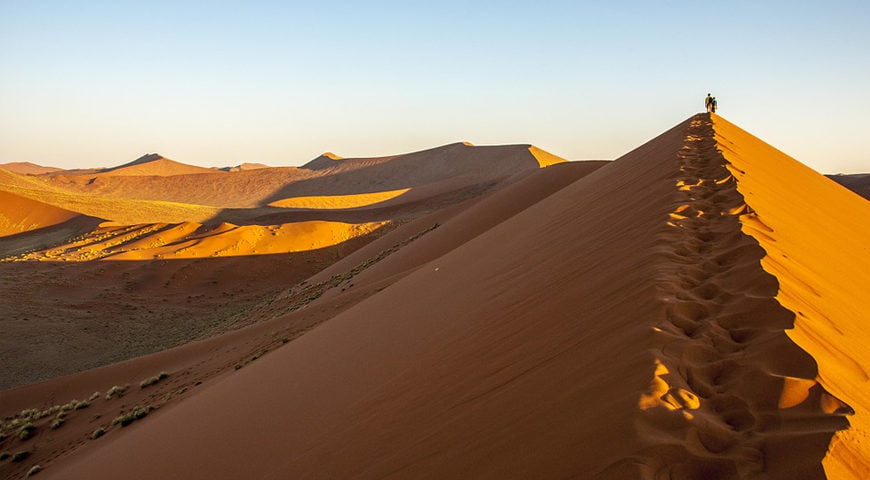The Namib is a coastal desert in Southern Africa. There are many reasons why people fall in love with this particular desert. It has some of the tallest duns in the world, red sand, and chance to see oryx.
The name itself means “vast place”. According to the broadest definition, the desert stretches for more than 1,200 miles along the Atlantic coasts of Angola, Namibia, and South Africa.
It consists of sand seas near the coast, while gravel plains and scattered mountain outcrops occur futher inland.
Let’s take a look at some of the unique facts about the Namib desert.
The World’s Oldest Desert
it is hard to imagine what has been in this world thousands of years ago. According to some studies, the Namib has been dry for at least 55 million years, and possibly as many as 80 million.
For comparison, Sahara has been around for only 12,000 years. With that in mind, Namib is certainly the oldest desert in the world. Parts of the desert are among the driest places on Earth, with just 2mm/0.08in of rain a year.
Stunning Scenery
One of the reasons why travellers, tourists, and photographers love the desert is the stuning scenery. It has a great view that can offer different attraction sources. Take for example the dunes with their colorful character in parts like Deadvlei, Hiddenvlei, and more.
![]()
Or you can take photos of the great landscape view, scenic beauty, birds, animals, and plants.
A strange climate
Namib has some of the strangest and most unique climate you have ever seen and felt. As you move to the interior of the desert, the blast of cold air and rolling mists can be deeply unsettling.
The Namib desert experiences about 180 days of fog every year. That is thanks to the cold air from the offshore Benguela current crashing up against the hot air.
The Skeleton Coast
Namib is a large part of Namibia. And that is where the Skeleton Coast is found. No one knows exactly how many ships foundered along the arid shore of Namibia.
Those that remain serve as reminders of the elemental force that controls everything along this coast. The sand dunes are so powerful, that their relentless march has reclaimed land from the sea.
![]()
Some of the popular ships that sank close to the coast include the Eduard Bohlen, sanking in Walvis Bay in 1909 and the Otavi, a cargo ship that sank in 1945.
The desert was a forbidden land
Up until recently, people couldn’t fully explore the Namib desert. Up until 2009, the Sperrgebiet region, which is now a national park known as Tsau Khaeb, was off-limits.
That area was a secretive place of abandoned diamond mines and many more conspiracies. These days, it is still only available to the select few adventures who have the courage to go there.
Desert Lions
This might surprise you, but the desert is home to some lions. Not many lions managed to survive in the Sahara Desert. Yet, a small population of them still exists in the Namib Desert. The somehow eke out an existence along the beaches, sand dunes, and barren mountains of the Kunene region.
![]()
They felt nearly extinct during the 1980s. The population has made a remarkable recovery, with almost 200 lions thought to be living in the area.
Elephants
Lions are not the only animals that manage to survive in the desert against all odds. Elephants do as well. The world’s largest land mammal somehow survives in one of the driest places on the planet. It is a miracle.
These desert-adapted giants are slimmer than their savannah counterparts, but still manage to survive. According to research, there are 600 elephants in the desert.
The epic sand dunes
Take a close look of the dunes and you will be left speechless. Some duns here are 328 yard high and stretch for more than 20 miles. There are not many longer sand dunes in the world. These towering mountains of sand are both striking and great fun to explore.
![]()
The highest is Dune 7, reaching height of 383m. The most popular place to visit the giant dunes is Sossusvlei.
When is the best time to visit?
Namib desert is open for tourism activities throughout the year. Yet, there are times that are more favourable and suitable for tourists. May to September is generally thought as the best time to visit the Namib.
The weather condition is less hot. Do not try to visit from July to November. That is the high season, when the desert gets busier because it becomes more congested and the season rates are applicable. Visiting during this time is also more expensive.
November to April is the best time for birding and for photographing that beautiful scenery we talked about previously.



